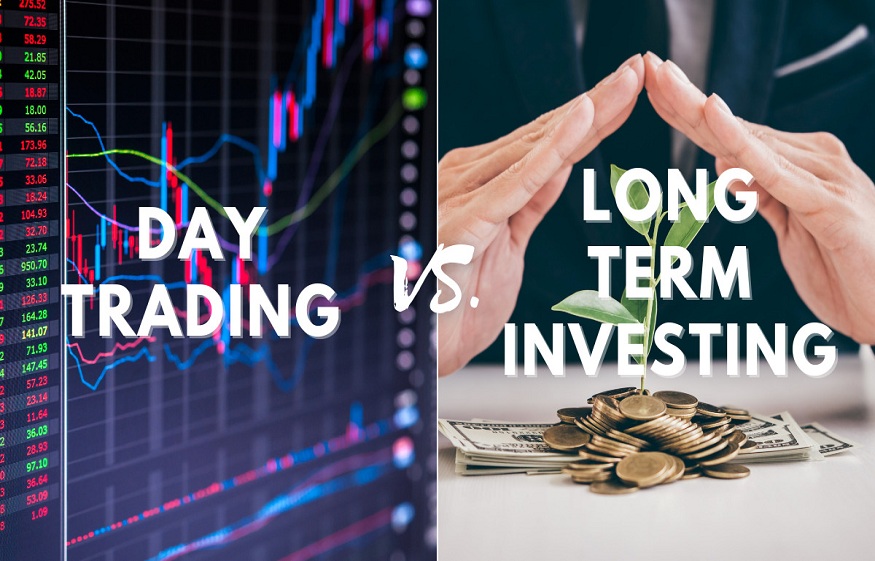When you make long-term stock investments, you shall hold your investment for a longer duration. Possibly from one to fifteen years or longer. In contrast, day trading entails closing your positions on the same day. When you engage in intraday trading during the day, for example, you have not owned a stock for longer than one day.
Let’s discuss the distinctions between intraday trading and long-term in this article. We will take into account variables like the holding duration, the potential for capital growth, the presence of risk, etc.
Long-term Investing Vs. Intraday Trading
The following are the key differences between long-term investing and intraday trading on the basis of different parameters.
1. Period of Ownership
Stocks that are long-term investments are kept for many years, and daily and short-term volatility have little impact on your investing choices. The length of your stay may be anything from one year to five years or more at your request. comparing intraday trading with long-term investing. You did not keep open positions for longer than a few hours during a trading day, as opposed to intraday trading. For the same day, holding periods can last anywhere between one minute and several hours, but only between trading hours. If not, the penalty charges will be automatically applied.
2. Capital Growth
Before the end of the day’s trading hours, traders will withdraw their positions when investors judge that the price is moving in the anticipated upward direction. For instance, if you invest Rs.100 in 100 shares of ABC Ltd. and the price increases to Rs. 110, you can sell the shares and profit. Similarly, you may lessen your losses in the event that a price rapidly drops by using trading tools like stop loss.
The decision you make won’t be impacted by short-term price swings in a long-term investment, though. You can accumulate money through capital gains by holding equities for a long time.
3. Cost Of Trading
Since just a few assets or positions are maintained for a prolonged period of time, long-term trading has cheaper costs due to reduced brokerage fees or asset turnover costs. Due to the number of transactions an intraday trader does throughout a trading day, there is a larger brokerage or commission associated. Although with the advent of trading apps, online trading in the share market has reduced trading expenses significantly. Yet, intraday trading may be costlier than long term investing.
4. Choosing Stocks
One must carefully select stocks or shares with the potential to increase in value and provide positive long-term returns while engaging in long-term trading. The goal of intraday trading is to make rapid profits during the trading hours of a particular trading day. As a result, stocks with more volatility are sought out in order to profit from price changes.
5. Trading Approach
Anyone may invest for the long term investment there is no need for expert skilled traders. However, the continual monitoring of price changes necessary for intraday trading necessitates a significant time investment. Therefore, professional traders are the ones who typically do this.
6. Required Information
Traders aim to earn more from daily price swings. Large losses may result from this. The price changes that occur during trading hours are used to identify intraday stocks. It depends on how volatile the stock markets are. On the other hand, long-term investors base their investments on fundamentals and the growth of the firm over time rather than trends. They retain the stock in a passive manner until the target price is attained.
What’s The Right Strategy?
Selecting the best trading strategy is a crucial choice that should be based on your own risk appetite, objectives, and preferences. Consider the following important aspects while making your choice.
Risk tolerance: Your level of comfort with risk will determine your risk tolerance. The greatest strategy for you may be long-term trading if you are risk-averse. Intraday trading may be a better alternative if you are more at ease with risk.
Aim of Investing: What do you want to accomplish by trading? Are you trying to make instant profits or are you trying to accumulate cash for your golden years? Consider this point extensively before you start investing.
Preferences: Do you possess the time and resources necessary to commit to day-to-day trading? If not, long-term trading can be a better option for you.
Summing Up
Investors can opt to be day traders, or long-term investors depending on their financial goals and investing objectives. Intraday is riskier than long-term investment, therefore novice investors should try to steer clear of them. But there are several prospects for profit in intraday trading, provided one invests enough time in analysing and monitoring market fluctuations.
You can also reach out to a professional to curate a personalised trading strategy. Well-known firms like Kotak Securities have experienced professionals. They shall interpret your investing objectives and curate a trading approach. The firm also offers one of the best demat apps to open investment accounts at low costs. So, you can engage in both intraday and long-term investing conveniently.

